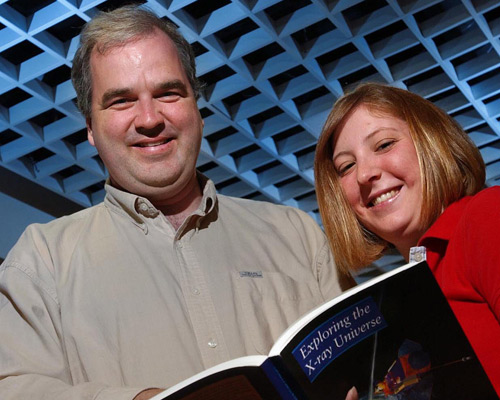Trustee Scholarship recipient Malinda Saia ’04 (Turnersville, N.J.), a physics major, is engaging in research that will challenge or support our understanding of the universe and the laws that govern it. She is working as an EXCEL Scholar with Michael Stark, assistant professor of physics, on a project to understand the orbital motion of Cygnus X-3, a binary system of stars.
“I chose this project because I have no background in doing research and wanted to gain experience,” says Saia. “I am very glad to be working with Professor Stark. I took one class with him, Quantum Theory, prior to this research. I enjoyed it very much and am excited to have the opportunity to work with him this summer.”
“Scientists must be able to carry out independent research to answer questions that arise in their daily work,” says Stark. “Mindy is getting the experience of working on a research project where we know what questions we want to answer, but are not sure how to go about answering them. We have a lot of data available to us and we have several ideas about how to analyze them.”
Gaining insights into the Cygnus X-3 system will yield a better understanding of neutron stars and black holes.
“This will challenge or support our whole understanding of the universe and the physical laws that govern it,” says Stark. “Even given the difficulty of carrying out this research, we may yet succeed.”
One of the greatest challenges of this research project is earth’s distance from Cygnus X-3. “Cygnus X-3 is 25,000 light years away,” says Stark. “That means if you could travel 186,000 miles per second, it would still take 25,000 years to get there from here.”
Saia and Stark are making use of some of NASA’s latest satellites, the Chandra X-ray Observatory and the Rossi X-ray Timing Explorer.
“These satellites detect X-rays from distant stars and return data about the X-rays to earth. Since these satellites are quite complex, we are using software designed specifically for these missions,” says Stark.
“Mindy is particularly intelligent and persistent,” he adds. “She is able to pick up what she needs fast and is free of the timidity that many students have when they are in new intellectual territory.”
A graduate of Washington Township High School, Saia is a two-year member of the varsity swimming and diving team and serves as secretary of Physics Club.

A National Leader in Undergraduate Research. Malinda Saia ’04 coauthored an article in The Astrophysical Journal with Michael Stark, assistant professor of physics.
